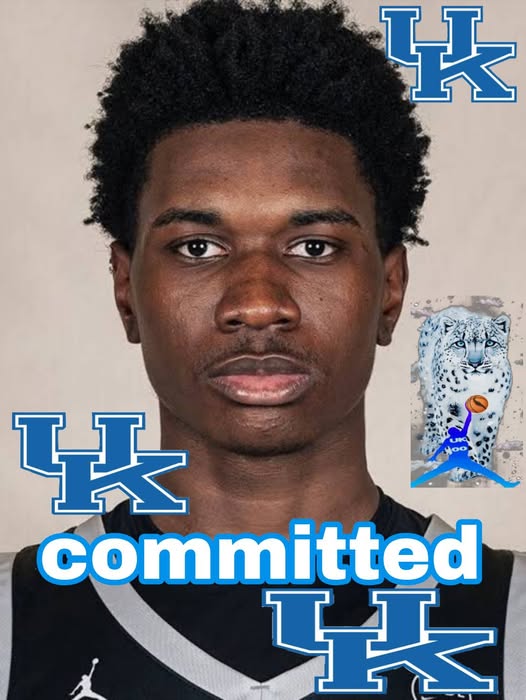When the nation’s top basketball recruit makes a decision, it reverberates throughout the college basketball landscape. Recently, the No. 1 player in America faced a highly anticipated recruitment battle among three Southeastern Conference powerhouses: Kentucky, Tennessee, and Georgia. In a move that has captured the attention of fans, analysts, and scouts alike, the star prospect ultimately committed to Kentucky, turning down the offers from Tennessee and Georgia. This decision didn’t come lightly; it was influenced by a combination of factors ranging from Kentucky’s storied basketball tradition and coaching staff to player development opportunities and the fit within the program’s culture. To understand why the nation’s best prospect chose Kentucky over its regional rivals, it’s important to dig deep into the motivations and considerations that drove this landmark commitment.
Kentucky’s basketball program is synonymous with success, boasting one of the most decorated histories in NCAA basketball. The Wildcats have claimed multiple national championships, produced numerous NBA stars, and consistently field teams that contend at the highest levels. This rich tradition of excellence offers a magnetic pull for any elite recruit who dreams of playing on the biggest stages, not only in college but eventually at the professional level. For the No. 1 player, Kentucky’s name on a jersey is more than just a program—it’s a gateway to basketball immortality. The Wildcats’ history of grooming top-tier talent, such as Anthony Davis, John Wall, Karl-Anthony Towns, and Devin Booker, is a compelling narrative that resonates deeply with any young athlete with aspirations for the NBA.
Another critical factor in the decision was the coaching staff at Kentucky. Head coach John Calipari is one of the most respected and successful recruiters and developers of young talent in the sport. His ability to connect with players, understand their goals, and prepare them for professional careers is almost unparalleled. The prospect recognized that under Calipari’s guidance, his skills and potential would be maximized. Calipari’s coaching style, which emphasizes player empowerment, skill development, and offensive creativity, aligns perfectly with the player’s own style of play and career ambitions. Furthermore, Calipari’s proven track record of navigating the college basketball landscape—balancing team success with individual player growth—offered a blueprint for how the prospect could thrive and elevate his game.
Kentucky’s exposure on the national stage also played a pivotal role. The Wildcats consistently play in high-profile games and tournaments, including the NCAA Tournament, and frequently headline national broadcasts. This kind of visibility is invaluable for a top recruit who not only wants to challenge himself against the best competition but also seeks the spotlight that can lead to endorsements and professional opportunities. Kentucky’s regular schedule against other elite programs and its fanbase’s intense passion ensures that players develop in a competitive yet supportive environment. Compared to Tennessee and Georgia, Kentucky’s basketball program remains the more prominent platform to showcase talent on a national level.
In addition to tradition, coaching, and exposure, Kentucky offers an infrastructure and resources that cater to elite athletes. The facilities at Kentucky are state-of-the-art, including world-class training centers, recovery technology, and academic support systems. For the No. 1 player, these resources promise not only athletic development but a holistic experience that nurtures both body and mind. The program’s commitment to providing athletes with everything they need to succeed—from nutritionists to sports psychologists—created a reassuring and enticing environment. While Tennessee and Georgia have made significant investments in their programs, Kentucky’s consistent prioritization of basketball excellence through facilities and support was a decisive factor.
One cannot overlook the chemistry and team environment the recruit felt at Kentucky. During official visits and meetings, the player reportedly felt a strong connection with the current roster and coaching staff. The camaraderie and competitive yet collaborative culture at Kentucky stood out as a perfect fit. Feeling comfortable in a team’s culture and believing in the collective vision can be just as important as any other tangible factor. The No. 1 player saw a group of peers equally driven and committed, with a culture that supports individual expression and collective success. This atmosphere contrasts with the slightly more uncertain environments at Tennessee and Georgia, where programs are still building toward consistent national prominence.
The player also weighed the paths for immediate playing time and leadership roles. Kentucky, with its reputation for bringing in multiple elite players each year, might seem like a crowded roster on the surface, but the recruit and the coaching staff clearly mapped out a plan for his role. The prospect was assured that he would have ample opportunity to contribute right away, learn, and grow within the system. Unlike some programs where top recruits might be one of many and struggle to find their niche, Kentucky presented a clear and confident vision for the player to step in as a foundational piece. Tennessee and Georgia, while promising, could not guarantee the same level of immediate impact or role clarity at this moment in time.
Recruitment philosophies and relationships played a big part in the decision as well. The recruit and his family emphasized the importance of trust and transparency throughout the recruitment process. Kentucky’s staff was noted for its openness, consistency, and genuine investment in the player’s long-term success beyond basketball. The family was looking for a program that would provide mentorship, stability, and guidance both on and off the court. Calipari and his team’s ability to communicate their vision clearly and build a strong rapport made Kentucky stand apart. Tennessee and Georgia, despite strong pitches, could not match that level of connection and reassurance.
The role of the NBA pipeline was another compelling consideration. Kentucky’s unparalleled history of producing first-round NBA draft picks and preparing players for professional success is a major draw for elite talent. The No. 1 player dreams of playing at the highest level and recognized that Kentucky offers a proven track record of helping players reach that goal quickly. The Wildcats’ ability to showcase players in ways that highlight their strengths and elevate their draft stock is unmatched in the region. This pipeline advantage makes Kentucky a strategic choice for a recruit who sees college basketball as a stepping stone rather than an end goal.
Academic and personal development opportunities also factored into the decision. While basketball was the primary focus, the player’s family placed importance on a program that values education and personal growth. Kentucky’s resources for student-athletes, including tutoring and life skills programs, ensure that players are prepared for success beyond the court. The holistic approach Kentucky promotes aligned with the family’s vision for the recruit’s development as a well-rounded individual. Tennessee and Georgia offer strong academic environments, but Kentucky’s long-established support system for athletes tipped the scales.
Geographically, the choice also made sense. Kentucky’s campus is located in Lexington, a basketball town with a passionate fanbase that lives and breathes Wildcats basketball. The community support creates an energizing environment that encourages players to perform at their best. For a young athlete seeking a sense of belonging and pride in representing his school, Kentucky’s basketball culture offered unmatched excitement. While Tennessee and Georgia have strong fan bases and growing basketball traditions, the cultural fervor for basketball in Kentucky remains something special and unique.
Finally, the momentum and timing of the decision were crucial. Kentucky entered the recruitment trail with strong momentum, making an early and consistent push that built confidence in the program’s dedication to the player. The seamless process and clear communication reduced uncertainty and anxiety for the recruit and his family, who valued a smooth and transparent recruitment experience. Tennessee and Georgia, despite having strong pitches and attractive offers, could not keep pace with Kentucky’s intensity and consistency in this recruitment cycle.
In summary, the No. 1 basketball recruit’s decision to choose Kentucky over Tennessee and Georgia was shaped by a constellation of interrelated reasons. Kentucky’s unmatched basketball tradition, elite coaching under John Calipari, national exposure, top-tier facilities, and a winning culture all played critical roles. The promise of immediate playing time, the strength of the NBA pipeline, and the genuine relationships built during recruitment further cemented Kentucky as the best fit. Add to that the supportive academic environment and passionate fanbase, and it’s clear why Kentucky stood out as the destination of choice for America’s top basketball prospect.
This commitment not only solidifies Kentucky’s place as a premier destination for elite talent but also sends a strong message across college basketball: when the nation’s best players are looking for the right place to develop, compete, and prepare for professional success, Kentucky remains the gold standard. For Tennessee and Georgia, the loss is a reminder of the challenges they face in climbing to the top tier of college basketball recruiting. For Kentucky, the addition of this No. 1 prospect signals a promising future filled with high expectations, fierce competition, and the relentless pursuit of championships.



